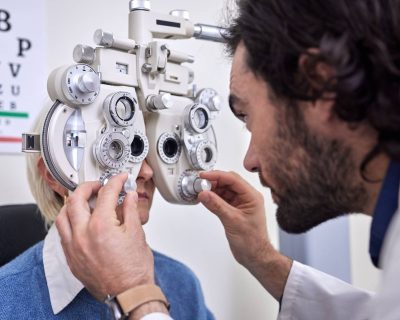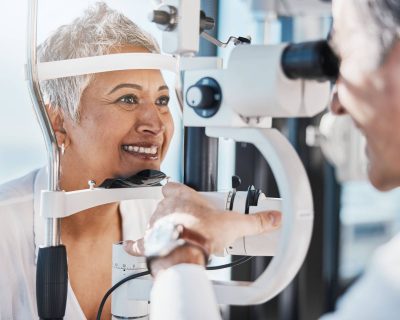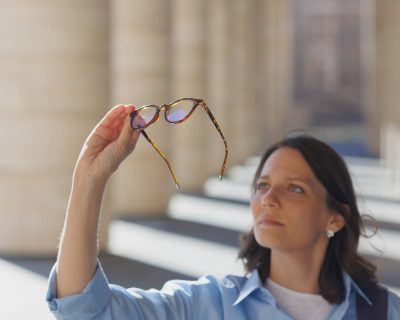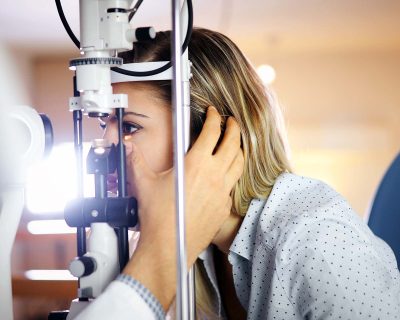
Understanding Hyperopia: The Basics of Farsightedness
Hyperopia, commonly known as farsightedness, is a vision condition where distant objects are seen more clearly than nearby objects. It occurs when the eyeball is too short or the cornea has insufficient curvature. Hyperopia can be present from birth and may be influenced by genetic factors. Some children may experience some farsightedness, which can decrease as the eye grows and changes shape during development. However, some people may continue to be farsighted into adulthood.
Here are some symptoms associated with hyperopia, or farsightedness:
Blurred Vision for Close Objects
Individuals with hyperopia often have trouble seeing clearly up close. Hyperopia blurs vision for close objects because of the way light is focused in the eye. In a normal eye, light is refracted by the cornea and lens to converge and focus on the retina, creating a clear and focused image. With hyperopia, the eyeball is too short or the cornea has too little curvature. The light entering the eye is not refracted enough, and the focal point of the light falls behind the retina instead of directly on it. Since the light is focused behind the retina, the eye perceives nearby images as blurry, making it difficult for individuals with hyperopia to see objects clearly at close distances. Due to the blurred vision, individuals with hyperopia may find it challenging to perform tasks that require attention to detail at a close range, such as reading, writing, sewing, or working on a computer. To address this, individuals with hyperopia can wear corrective lenses. These lenses converge incoming light rays, allowing nearby images to focus correctly on the retina and improving vision for close-up tasks.
Squinting
Some individuals with hyperopia might unconsciously squint to see more clearly, especially when working on tasks that require close focus. Squinting involves partially closing the eyes to reduce the aperture through which light enters. By narrowing the opening through which light enters the eye, squinting allows for a slight change in the way the light converges on the retina. This can temporarily improve the focus of light and bring the image of a close-up object closer to the focal point on the retina. Squinting also reduces the amount of peripheral light that enters the eye. By minimizing peripheral light, the individual may enhance their ability to see the central object more clearly. While squinting can be an instinctive response to hyperopia, it is not a permanent or ideal solution. It is often a sign that the eyes are struggling to focus. Prolonged squinting can contribute to eyestrain and discomfort. To reduce the need for squinting, individuals with hyperopia are typically prescribed with corrective lenses that can compensate for the refractive error.
Eye Discomfort
Hyperopia may cause general eye discomfort or aching, especially during tasks that involve sustained focus on nearby objects. Individuals with hyperopia need to exert extra effort to adjust the focus of their eyes for close-up activities. To compensate for the blurred vision, the eye’s muscles work harder to accommodate and bring nearby images into focus. Engaging in tasks that require prolonged focus on close objects, especially without the appropriate correction or treatment, can lead to eyestrain. This can manifest as a feeling of fatigue, discomfort, or soreness in or around the eyes. Furthermore, prolonged periods of close work may also reduce the frequency of blinking, leading to dry eyes. Insufficient lubrication on the eye’s surface can result in discomfort and irritation. Corrective lenses can reduce the need for excessive eye muscle effort, minimizing eye discomfort and associated symptoms.
Headaches
Hyperopia can contribute to headaches due to the extra effort required by the eyes to focus on close-up objects, particularly after prolonged periods of reading or other close activities. When individuals with hyperopia engage in tasks that require close focus, the ciliary muscles within the eye, which are responsible for adjusting the shape of the lens to facilitate focusing, must work harder than usual to bring close objects into focus. Strenuous use of these muscles can result in fatigue and eyestrain, which is a common precursor to headaches. The muscle strain and fatigue associated with hyperopia-induced eyestrain can trigger a tension headache, which presents as a dull, achy pain that can radiate from the forehead to the back of the head and neck. Individuals with hyperopia can wear corrective lenses, which can help reduce associated eyestrain and headaches.
There are several treatment options for individuals with hyperopia. As previously mentioned, hyperopia can effectively be treated with corrective lenses, such as eyeglasses or contact lenses. Prescription glasses with convex lenses can help converge light rays before they enter the eye, allowing for proper focus on the retina. Eyeglasses are worn on the face, positioned in front of the eyes. On the other hand, contact lenses sit directly on the eye. They can provide a more natural field of vision without the need for frames. Some individuals can opt for refractive surgery, which can reshape the cornea to adjust how light enters the eye, improving its focus on the retina. However, not everyone is a suitable candidate for refractive surgery, and the decision to undergo this procedure should be made in consultation with an eye care professional. At the end of the day, the choice of treatment depends on the individual’s preferences, lifestyle, and degree of hyperopia.
An eye examination with an optometrist can detect and monitor hyperopia and eye health. An optometrist can determine the degree of hyperopia or farsightedness and recommend appropriate corrective measures. To maintain your eyes’ health, be sure to visit your optometrist regularly for an eye examination.





1 comment on “Understanding Hyperopia: The Basics of Farsightedness”